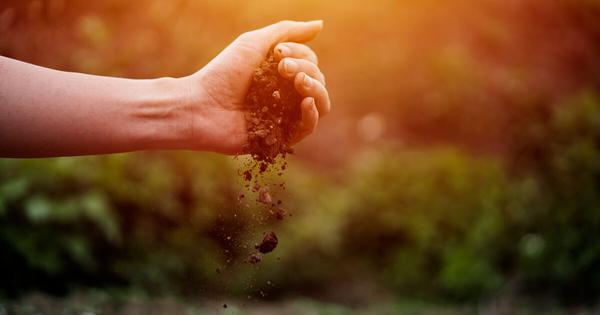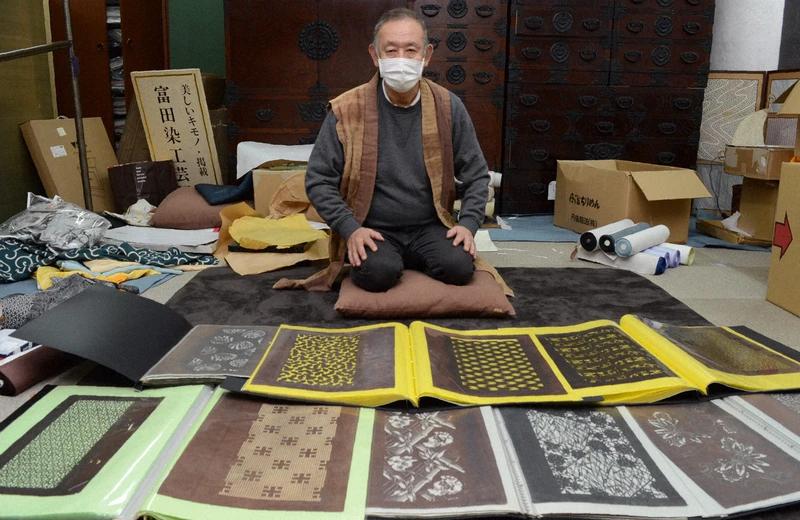The Japanese version of the magazine "WIRED" is published four times a year. The latest issue, VOL.40 (released on March 13th), features food for the first time in 6 years. Is it possible to seek an organic connection with soil and nature from food while satisfying people's appetite? Explore the possibilities of a "future dish" that reincorporates food innovation into the great cycle of nature. >> Click here for details such as PDF for members.
"Agriculture must change during this century, to address the food problems of the world of the future." It was geologist David Montgomery who revealed a sense of crisis in the fifth lecture of the WIRED SZ membership webinar "Future Image of Food Innovation". According to him, the world loses 0.3% of its food production capacity each year, mainly because of the loss of fertile soil.
"You may not feel that 0.3% is a big number. It's about bank interest. But think about it in a span of 100 years. Then half of your food production capacity will be lost by the end of the 21st century. It will be a calculation that will be broken. "
The decline of the soil, which is said to have started from the moment human beings put a plow into the ground. Through the history of modern agriculture, which ignored the symbiotic relationship in the ground and relied on nitrogen fertilizers and pesticides, until the future when we began to find a way to live in the "invisible" symbiotic relationship in the ground, we will regain the soil. Was developed over a two-hour period, vividly answering various questions from listeners from a geological point of view. In addition to the world of microorganisms that spreads in parallel with the soil and the human body, which has become a particular highlight, the ideal way of eating to regenerate nature, which is the theme of the latest issue of the upcoming "WIRED" Japanese magazine. Let's introduce the scene of the talk session where we talked about such things.
David Montgomery | DAVID MONTGOMERY Professor, Geomorphology Research Group, Department of Geomorphology, University of Washington. His main research themes are the development of topography and the impact of geomorphological processes on ecosystems and human society. Received the 2008 Washington State Book Award in the General Nonfiction category for "History of Civilization of the Earth". His home page is https://www.dig2grow.com/. (@ Dig2Grow).Life is run from an invisible world
Akiko Okada: The English title of the book "Soil and Viscera (The World Created by Microorganisms)" is "The Hidden Half of Nature: The Microbial Roots of Life and Health". At first I was wondering what it was like, but as I read it, the scales really fell from my eyes. While taking in various natural elements such as sunlight and water, I was keenly aware that it was difficult to realize that the roots of plants and microorganisms cooperated in the soil.
David Montgomery: Regarding the world of microorganisms, what is happening in our intestines is actually quite parallel to the perimeter of the roots of plants (rhizosphere) in the soil. If you turn the rhizosphere upside down, you'll find that it looks a lot like the human digestive tract. It wasn't until the 17th century that we learned about microorganisms, but the relationship between microorganisms and their host organic matter "symbiosis" was a huge discovery. The host (human) cannot see the world of microorganisms. But in reality, it is the microorganisms that run our farmland and our lives.
Over the last decade, we have gained a better understanding of the importance of symbiosis, and we are pioneers-for example, farmers such as Masanobu Fukuoka in Japan and Albert Howard, a botanist and leader in organic farming in the United Kingdom. ─ I think we were able to further strengthen our ideas, but conversely, I think it took time for humankind to understand how symbiosis works.
Axis for breaking away from conventional farming vs. organic farming
Tomoaki Matsushima: When you read "The One-Straw Revolution in Natural Farming" by Masanobu Fukuoka, who advocated natural farming, you insist that you value spirituality very much and refuse science to live with nature. .. On the other hand, in "Soil and Internal organs", science is used to logically elucidate "why natural farming works", and I think this is exactly the epoch-making part of Mr. Montgomery's book.
Even in modern times, agriculture is still often talked about on the opposite axis of nature vs. science and conventional agriculture vs. organic farming. How can we put a science-based axis apart from using / not using fertilizer?
Montgomery: It's easy to divide into science and traditional approaches, but I think this is a mislead. In modern conventional agriculture, cultivators have been used and chemical fertilizers have been used. This style of farming is rooted in the science of the 1940s and 1950s and is, so to speak, the foundation. Chemistry and physics were important in science at that time, and biology was missing there.
What we say in "Soil and Viscera" is that we have only recently learned that ecology promotes symbiosis, which is related to the fertility of the land. Now we are trying to figure out what organic matter is contained in the soil. It is a new area of research where the interaction in the presence of many microorganisms is not yet fully understood.
What I mean is that the combination of modern agricultural science and biology provides a better understanding. No-tillage without cultivators (from reflections on soil destruction data from past agriculture), cultivation of covered crops and rotation of various crops-these three are very important. In particular, if the soil is cultivated with plows, the activity of microorganisms will be suppressed, so even if the soil is covered or cropped, it will take time for the land to become fertile.

This does not mean that we are going back to agriculture in the 13th century. We are not abandoning science, but rather trying to improve farmland by understanding the future of agriculture at an ecological level and combining it with various technologies.
What is the way to eat to regenerate nature?
Matsushima: Thank you. The Japanese version of "WIRED" featured a new food innovation that does not put a load on the soil by continuing production away from the so-called earth, such as cultured meat and vegetable factories, six years ago. In fact, the latest issue of the magazine, which will be released soon in March, also features food, and asks the question, "What is the way to eat to regenerate (regenerate) nature?"
Therefore, I would like to ask Mr. Montgomery what the ideal form of livestock should be in the sense of regaining the fertile land, which is written in the book "Soil, cattle, microorganisms-a story of soil that stops the decline of civilization". What we are thinking about, and how to develop GM crops (GMOs) that are resistant to changes in the environment that are expected in the future as the environmental crisis approaches, are especially poor farmers in developing countries. It is important for you, but what are your thoughts on that?
Montgomery: The role that livestock play in future agriculture is important. I also know a farmer who actually used livestock to regenerate the grassland, and found that the quality has improved, such as an increase in omega 3 in milk. As for livestock, it is not good or bad in itself, but I think we have to look at whether the way they are raised makes the soil fertile or deteriorates. It is important to raise livestock that restores the health of the soil.
Raising livestock in a closed environment results in deterioration of the land and soil itself. Whether it's vegan or vegetarian, or eating / not eating meat is an individual choice, and I'm not in a position to say anything about it, but how did what I eat grew up, and more specifically, the soil. We have to ask ourselves whether we left it in good condition or made it worse.
I think GMO is a fairly complicated subject. From the knowledge I gained from reading the GMO literature, I think that the greatest health effect is actually due to the use of herbicides (glyphosate) that accompany the cultivation of GMO. There are many reasons to worry about the impact of glyphosate on soil microbiota, livestock microbiota, and potentially human microbiota-data on human relationships are now available. There are few, though. Also, there has been a lot of debate about whether it is carcinogenic, and I don't think that question has been resolved. But using this amount of pesticides is certainly a good reason to be concerned about the lives of microorganisms in our bodies and in our crops. I'm not philosophically opposed to GMO, but I don't think we should put all of our energy into that territory.
The theme for Thursday, January 13 is "Carbon-neutral future pioneered by Euglena's biofuels." The guest is Akihiko Nagata (CEO of Euglena / Representative of Real Tech Fund). Click here for details.Rich soil fosters deliciousness and health
Okada: I received a lot of questions, and one of them was "What is the relationship between soil fertility and health and deliciousness?" What do you think of Montgomery?
Montgomery: That's a very good question. My new book, published in 2022, also addresses that question in terms of where the taste comes from. The simple answer is that healthy, fertile soils are expected to grow plants that are also richer in the components that underlie the taste. This is not exactly the case for all, but there may be strong evidence that there is a correlation between healthy soil and taste.
Okada: Thank you. I am very much looking forward to the publication of the Japanese translation version.
Matsushima: Microorganisms in the soil improve the quality of the soil and affect the taste of food. So what is the impact on the microbiome of humans living on the soil? This is the theme that was taken up in the "WIRED" SZ membership article, but please let us know that it is scientifically elucidated how rich the soil is and how dynamically the bacteria in our body change.
Related article: Microorganisms and immunity: After moving the "forest" to an urban playground, the environment of children's bodies has become more diverse.
Montgomery: Research on how humans are exposed to soil and how organic matter affects human health is very interesting. Research on the effects on asthma etc. has also been done, and it is said that up to 3 or 4 years old is especially important. In short, exposure to microorganisms is very important for humans. It is said that human immunity is strengthened by being involved in the soil.
There are two ways in which earthly life can directly affect us. One is through direct contact with our immune system. Studies show that children playing in the soil tend to be healthier than those who do not. Children playing in the soil have a well-developed immune system and are trained to get rid of pathogens.
The other is the influence of the crops you eat. Long ago, our ancestors picked fruits directly from the surface of the earth and put them in their mouths. Perhaps these acts have the origin of the microbiome in modern humans. Probiotics and fermented foods are said to be very good for the body, but it is said that all the organic substances that enter the mouth are not digested by the stomach and some of them reach the intestines.
It is said that the microbiota in the body changes in a fairly short period of time depending on what we say. It changes every few days. So I think it is possible to adjust the human microbiome by what we eat.
We also need to ask who is benefiting from food. From that point of view, I began to think about my eating habits. Choosing what to give to the microorganisms in the body is the difference between victory and defeat. We all have different microbiota, although we all have something in common that we had ancestors who were connected to the soil. That's because it's important to connect with what we eat on a daily basis.
The theme of the latest issue is "Regaining" Food Sovereignty "by Commons." How is it possible for our community to regain "food sovereignty", such as choosing what we eat, producing and distributing it? Click here for details.



![[Amazon Time Sale Festival] Top 10 Recommended & Hot Selling Targets for "Smart Watch" Sale! Great deals on OPPO and HUAWEI](https://website-google-hk.oss-cn-hongkong.aliyuncs.com/article-website/google/2022/1/13/4cb456ebf7ab437d87a781ef92af88aa.jpg?x-oss-process=image/auto-orient,1/quality,q_70/format,jpeg)


